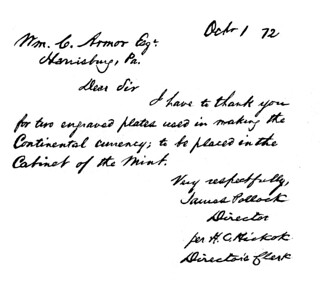
About UsThe Numismatic Bibliomania Society is a non-profit organization devoted to the study and enjoyment of numismatic literature. For more information please see our web site at coinbooks.org SubscriptionsThose wishing to become new E-Sylum subscribers (or wishing to Unsubscribe) can go to the following web page link MembershipThere is a membership application available on the web site Membership Application To join, print the application and return it with your check to the address printed on the application. Membership is only $20 to addresses in the U.S., $25 for First Class mail, and $30 elsewhere. For those without web access, write to: Terry White, Treasurer
AsylumFor Asylum mailing address changes and other membership questions, contact Terry at this email address: terrywhite5475@yahoo.com SubmissionsTo submit items for publication in The E-Sylum, just Reply to this message, or write to the Editor at this address: whomren@gmail.com BUY THE BOOK BEFORE THE COINSale Calendar |
- WAYNE'S WORDS: THE E-SYLUM MARCH 6, 2016
- BRYCE BROWN MAIL BID SALE #2 RESULTS
- LAKE BOOKS SALE #124 CLOSES MARCH 15, 2016
- NEW BOOK: COIN COLLECTING ALBUMS, VOLUME TWO
- NEW BOOK: COINS OF KIEVAN RUS' 988-1018
- KOLBE & FANNING HARDBOUND CATALOGUE SUBSCRIPTIONS OFFERED
- THE BANKNOTE BOOK
- NEWMAN NUMISMATIC PORTAL ANNOUNCES OPENING
- BENJAMIN MAXIMILLIAN MEHL (1884-1957)
- NUMISMATIC FIRM RARE LEGACY LAUNCHED
- DENOMINATIONS NAMED AFTER PEOPLE: SOMONI
- NOTES FROM E-SYLUM READERS: MARCH 6, 2016
- FUGIO CENT DIES USED AS PAPERWEIGHTS
- AMERICAN REGULATED GOLD PIECES
- CONTINENTAL CURRENCY PRINTING PLATES DONATED TO MINT
- THE PIRATES TREASURE CALIFORNIA GOLD SET
- SOME MORE HALF DIME TOKENS
- WHERE ARE THE PEALE REPORT DRAWINGS?
- "UFO" JETON RESURFACES IN POPULAR MEDIA
- THE U.S. MINT'S PALLADIUM BULLION COIN
- OBJECT OF INTRIGUE: CONFEDERATE CURRENCY
- 3D PRINTING IMPOSSIBLY HIGH RELIEF PRECIOUS METAL COINS
- SPINK TO SELL STEWARTBY COLLECTION OF ENGLISH COINS
- SOTHEBY’S 1913 SALE OF ARTHUR CONAN DOYLE’S COINS
- MTB’S 1968 PRICE LIST OF ARTHUR CONAN DOYLE’S ANCIENT COINS
- ARTICLE HIGHLIGHTS METAL DETECTOR HOBBYISTS
- METAL DECTECTORIST FINDS AN ENTIRE SAXON TOWN
- ROMANIAN POLICE SEIZE STOLEN COINS
- MALAYSIAN COIN COLLECTORS LINED UP FOR NEW ISSUE
- AUSTRALIA WWII REFUGEE CAMP SCRIP NOTES OFFERED
- SWISS 5-FRANC COIN TARGETED BY COUNTERFEITERS
- COUNTERFEIT SHOVER TARGETS CALIFORNIA GIRL SCOUTS
- HOBO CARVERS CREATE UNIQUE COIN PUZZLE ART
Click here to access the complete archive
To comment or submit articles, reply to whomren@gmail.com
WAYNE'S WORDS: THE E-SYLUM MARCH 6, 2016

New subscribers this week include: Michael Jenkins, Greg Cohen and Marc Merrick. Welcome aboard! We now have 1,954 subscribers.
This week we open with updates from numismatic literature dealers Fred Lake and Bryce Brown, two new books and the long-awaited opening of the Newman Numismatic Portal.
Let me take a minute to repeat that - the Newman Numismatic Portal is now open! While digitized content for NNP has been appearing regularly for some time now, this will be the first time the entire web site is fully available for use by the public. In addition to all the content previewed to date in The E-Sylum, there are dictionary entries, biographies, and auction prices available. Check it out!
Other topics this week include the Banknote Book, the U.S. palladium bullion coin, the Fugio Cent dies, American regulated gold pieces, California gold, 3D printing of precious metal coins, and the Lord Stewartby and Sir Arthur Conan Doyle collections.
To learn more about Coin Collecting Albums, B. Max Mehl, Julius Caesar and Leap Days, half dime tokens, the "flying saucer" jeton, the Malaysia Coloured Silver Commemorative Coin, and Australian WWII refugee camp notes, read on. Have a great week, everyone!
Wayne Homren
Editor, The E-Sylum
BRYCE BROWN MAIL BID SALE #2 RESULTS
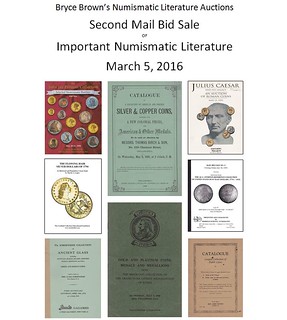 The Prices Realized List for my March 5th auction sale is now posted at http://www.bbnla.com/ .
The Prices Realized List for my March 5th auction sale is now posted at http://www.bbnla.com/ .
Thank you Wayne, and The E-Sylum, for your gracious support in posting news of my sale. Participation was outstanding! Nearly all bidders were winners, and a ton (well, maybe a half-ton) of professionally-wrapped packages will be in the mail shortly! My next sale is slated for late June or early July. It will feature an outstanding group of 19th century auction catalogs, along with one of the most significant groups of numismatic error & variety literature ever offered.
Bryce Brown's Numismatic Literature Auctions
P.O. Box 16
Avon, CT 06001-0016 USA
email: numismatics@att.net
Phone: 860-751-2555
Fax: 203-900-0249
www.BBNLA.com
LAKE BOOKS SALE #124 CLOSES MARCH 15, 2016
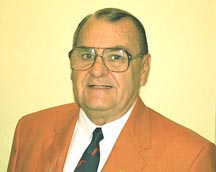 This is a reminder that our mail-bid sale of numismatic literature closes on Tuesday, March 15, 2016 at 5:00 PM (EDT) and you can view the
sale at http://www.lakebooks.com/current.html. Bids may be placed via email (preferred), telephone or fax until that time. The sale
features nearly 500 lots of United States catalogs, Foreign and Ancient catalogs, Books on United States money, also reference material on Paper
Money, Tokens and Medals and some wonderful miscellaneous finds. I want to express my deep appreciation for the many messages wishing me a speedy
recuperation from my accident that happened on January 7th. Let me assure you that I am progressing well and will be ready for your bids. Early
bidding is a big help and don’t forget ties are won by the earliest bid received.
This is a reminder that our mail-bid sale of numismatic literature closes on Tuesday, March 15, 2016 at 5:00 PM (EDT) and you can view the
sale at http://www.lakebooks.com/current.html. Bids may be placed via email (preferred), telephone or fax until that time. The sale
features nearly 500 lots of United States catalogs, Foreign and Ancient catalogs, Books on United States money, also reference material on Paper
Money, Tokens and Medals and some wonderful miscellaneous finds. I want to express my deep appreciation for the many messages wishing me a speedy
recuperation from my accident that happened on January 7th. Let me assure you that I am progressing well and will be ready for your bids. Early
bidding is a big help and don’t forget ties are won by the earliest bid received.
Good Luck with your bidding, Fred
Lake Books
6822 22nd Ave N
St. Petersburg, FL 33710-3918
727-343-8055 fax: 727-381-6822
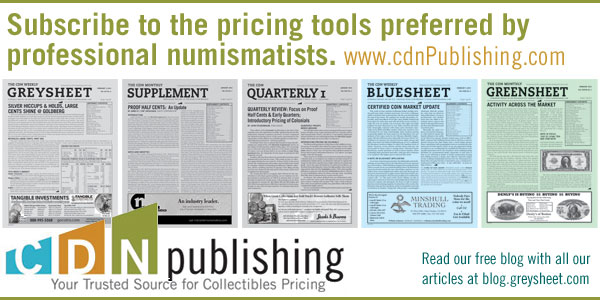
NEW BOOK: COIN COLLECTING ALBUMS, VOLUME TWO
Dave writes:
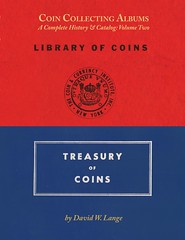 This is the second volume in my series of books titled Coin Collecting Albums: A Complete History & Catalog. It tells the story of
Robert Friedberg's Capitol Coin Company and its publishing division, The Coin and Currency Institute, Inc. The main emphasis, of course, is on
the coin albums produced by the C&CI---the Library of Coins and the Treasury of Coins lines. These are fully described and cataloged, as well as
being illustrated in color by titles and editions. The book is 144 pages, with 64 of them consisting entirely of color plates that show all of the
company's products in detail.
This is the second volume in my series of books titled Coin Collecting Albums: A Complete History & Catalog. It tells the story of
Robert Friedberg's Capitol Coin Company and its publishing division, The Coin and Currency Institute, Inc. The main emphasis, of course, is on
the coin albums produced by the C&CI---the Library of Coins and the Treasury of Coins lines. These are fully described and cataloged, as well as
being illustrated in color by titles and editions. The book is 144 pages, with 64 of them consisting entirely of color plates that show all of the
company's products in detail.
NEW BOOK: COINS OF KIEVAN RUS' 988-1018
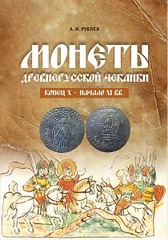 COINS OF KIEVAN RUS' 988-1018
COINS OF KIEVAN RUS' 988-1018
by A. Rublev
This publication contains a structured catalog of more than 930 coins struck in Kievan Rus' at the end of the 10th - beginning of the 11th centuries during the reigns of Vladimir, Svyatopolk and Yaroslav. It is a Corpus of all known specimens of these rare and significant coins. The previous work of this kind, published by Hermitage numismatist M. Sotnikova in 1995, included only 300 pieces - three times less than in this Corpus.
Russian language.
424 full colour pages.
Hard cover.
Issue limit - 300 pieces
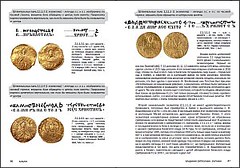
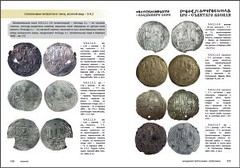
For more information, or to order, see:
http://wirecoins.de/kievan/
THE BOOK BAZARRE
KOLBE & FANNING HARDBOUND CATALOGUE SUBSCRIPTIONS OFFERED

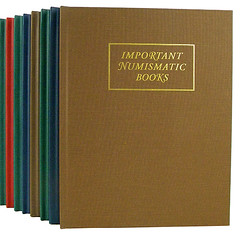 Kolbe & Fanning cloth hardcover numbered sale catalogues are available by subscription for $55 each.
Kolbe & Fanning cloth hardcover numbered sale catalogues are available by subscription for $55 each.
Billed when shipped. Earlier hardcover sales are also available for purchase at the subscription price if available.
To subscribe, see:
www.numislit.com/pages/books/3728/kolbe-fanning/kolbe-and-fanning-hardcover-catalogue-subscription
THE BANKNOTE BOOK

Martin Kaplan writes:
These days my numismatic focus is world paper money. I started around 60 years ago with Lincoln penny boards. Isn't that how all of us this old got started? I'm not sure you are aware of "The Banknote Book"? Forever the "Pick Catalog" was the standard world banknote catalog. Today Owen Linzmayer is creating the new standard online catalog. He updates his online catalog frequently...with both new information and pricing. I'm sure you have readers who are world banknote collectors who would enjoy learning about the new standard catalog... The Banknote Book.
As of 4 March 2016, 226 chapters (each a stand-alone country-specific catalog) of The Banknote Book have been published as individual high-resolution PDF files. This represents a total of 3,046 pages covering 30,495 varieties, including thousands of notes not listed in Krause’s “Pick” catalog, officially known as the Standard Catalog of World Paper Money (SCWPM).
If you do not see a country of interest listed below, please be patient. Some countries are much more challenging to complete than others due to the large number of notes to be cataloged, as well as the difficulty in obtaining information about and images of rare issues. However, rest assured that the goal is to cover every country as soon as possible.
For more information, see:
www.banknotenews.com/banknote_book/chapters_published/chapters_published.php
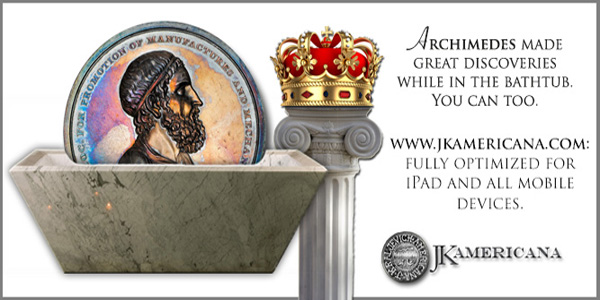
NEWMAN NUMISMATIC PORTAL ANNOUNCES OPENING
Below is the full press release issued today. Many thanks to Eric Newman, the Eric P. Newman Numismatic Education Society and Washington University in St. Louis for making this happen. It's been a pleasure to have been involved with the project since its inception. Be sure to visit the site and read up on your favorite numismatic topics. -Editor
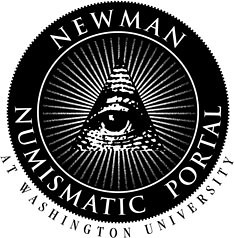 The Newman Numismatic Portal (NNP) is now live and open to the general public at NewmanPortal.org. Funded by the Eric P. Newman Numismatic Education Society (EPNNES), NNP is administered through
Washington University in St. Louis, and aims to provide the most comprehensive numismatic resources available on the Internet. “I have long wanted to
make the literature and images of numismatics, particularly American numismatics, available to everyone on a free and forever basis,” said Eric P.
Newman, president of EPNNES. “Today’s digital technologies, combined with the funds recently assembled from auctions of some of our foundation’s
holdings, now make this possible.”
The Newman Numismatic Portal (NNP) is now live and open to the general public at NewmanPortal.org. Funded by the Eric P. Newman Numismatic Education Society (EPNNES), NNP is administered through
Washington University in St. Louis, and aims to provide the most comprehensive numismatic resources available on the Internet. “I have long wanted to
make the literature and images of numismatics, particularly American numismatics, available to everyone on a free and forever basis,” said Eric P.
Newman, president of EPNNES. “Today’s digital technologies, combined with the funds recently assembled from auctions of some of our foundation’s
holdings, now make this possible.”
The Newman Portal project launched scanning operations at Washington University Libraries in July, 2015, and at the American Numismatic Society in November, 2015. Both locations are equipped with scanning equipment supplied in partnership with Internet Archive, as well as personnel to perform scanning on a full-time basis. Over 3,000 documents, representing more than 100,000 pages, have been completed to date. The documents represent a mix of auction catalogs, periodicals, reference books, and archival material. Most of this material is unique to the Newman Portal and has not been previously scanned.
In addition to the libraries of Eric P. Newman and the American Numismatic Society, a number of contributors including private collectors Dan Hamelberg, Bill Burd, and Joel Orosz have loaned material to the Newman Portal for scanning. The Newman Portal has further partnered with over a dozen specialty and regional organizations to provide access to back issues of club journals. A full list of available publications may be found in the periodical section of the Newman Portal at http://www.NewmanPortal.org/library/periodicals.
The Portal further includes reference content structured for optimal usage within the context of online access. Resources such as Pete Smith's American Numismatic Biographies and Albert Frey’s dictionary from the American Journal of Numismatics have been broken down into separate entries and appear individually in search results. The U.S. coin encyclopedia contains over 2 million auctions prices realized. A Lucene-based search engine allows users to search across all content, from the scans hosted by Internet Archive to the reference material within the site itself.
While ongoing scanning operations continue to build the “virtual library” of the Newman Portal, the long term goal of NNP is to increase collector collaboration and foster knowledge sharing through crowdsourcing and other initiatives. The Smithsonian Institute has recently demonstrated the promise of crowdsourcing in cataloging thousands of national bank currency proofs. The Newman Portal has announced its first such project, creating a transcription of Franklin Peale’s Report (1835), a fundamental document related to 19th century American coining technology. With today’s electronic resources, the power of the community can accomplish tasks beyond individuals or small teams, and the Newman Portal will enable this within the numismatic research space.
To visit the Newman Numismatic Portal, see:
www.newmanportal.org

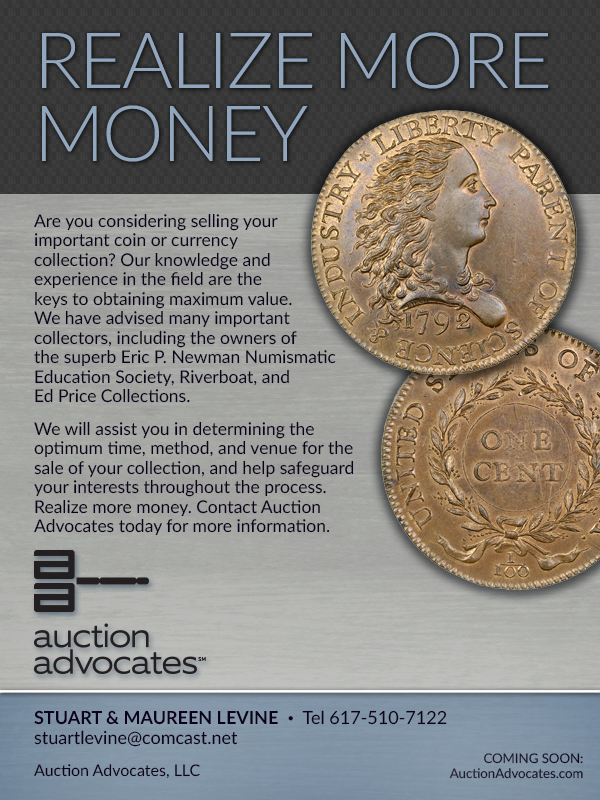
BENJAMIN MAXIMILLIAN MEHL (1884-1957)
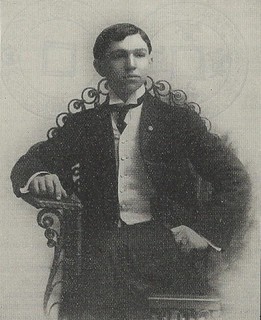 Benjamin Maximillian Mehl (1884-1957), was born on November 5, 1884 in the Jewish Quarter or ghetto of Lodz called Alstadt, Poland-Russia
(modern Poland), son of Solomon Isaac Mehl (1849-1929) and Rachel Mehl (1846-1926). All of the Mehl family were native born Polish-Russians. As
Polish Jews they were fluent in Russian, Hebrew and Yiddish, as well as all of their children. The surname Mehl is German, not Russian, and means
"ground meal" or "flour" which seems to refer to a family involved in that business at an earlier time when families were given
surnames based on their trade.
Benjamin Maximillian Mehl (1884-1957), was born on November 5, 1884 in the Jewish Quarter or ghetto of Lodz called Alstadt, Poland-Russia
(modern Poland), son of Solomon Isaac Mehl (1849-1929) and Rachel Mehl (1846-1926). All of the Mehl family were native born Polish-Russians. As
Polish Jews they were fluent in Russian, Hebrew and Yiddish, as well as all of their children. The surname Mehl is German, not Russian, and means
"ground meal" or "flour" which seems to refer to a family involved in that business at an earlier time when families were given
surnames based on their trade.
According to his brief biographical sketch in The Numismatist, March, 1905, page 89, his family moved to Vilkomir, Umerge district, province of Kovno (modern Kaunas), Lithuania, when he was an infant in 1885. This proved to be a bad move since there was an anti-Jewish riot there that year. Nevertheless, Ukmerge had been an important Judaic center in Lithuania for hundreds of years. The Hebrew school had been established there since 1868. A new building was constructed in the Autumn of 1884 for the Talmud Torah. It was in these schools that young B. Max Mehl learned reading, writing, Hebrew, Torah, translation, prayer interpretation, some Gemara, arithmetic and Russian. His family immigrated to America when he was ten years and five months old, in April 1895.
Fort Worth, Texas, had established a Jewish Congregation in 1892, and in 1895 constructed a synagogue. Also in 1895, they established a Young Men's Hebrew Association. Sometime after November 5, 1897, B. Max Mehl celebrated his bar mitzvah at Fort Worth. From the time the Mehl family arrived the Jewish community at Fort Worth grew stronger and more organized. Numbered among the earlier Jewish settlers at Fort Worth were Nathaniel and Jacob Washer, who opened a men's clothing store in that city in 1882. When the Mehl family arrived at Fort Worth, Benjamin’s father Solomon opened a clothing store competing with the Washer Brothers.
Benjamin began as a coin dealer from the coins that crossed his father’s counter in the clothing store and entered his collection rather than the cash register, certainly swapped by him with dad's approval in exchange for his weekly pay.
He began coin dealing from his home at 1211 Main Street, Fort Worth, using it as an office in December 1903. Apparently he did not do well on this mail bid auction since he seems to be selling much of the same material in his January 25th 1904 circular cited in the Post Scriptum.
His importance as a dealer was as a merchandizing promoter evidenced by his aggressive advertising, auctions, and publishing of several series of numismatic books and periodicals. The synergy he contributed to the coin industry during his fifty-two years as a coin dealer (1903-1955) occurred during a period of economic growth in the nation before, during, and after the depression that contributed to decidedly sharp market increases of closed sales prices on coins and paper money.

Earliest known circular of B. Max Mehl, January 25, 1904.
Courtesy Lupia Numismatic Library
Mehl knew the power of promotion and used every opportunity at his disposal to promote himself as the world's foremost authority and highest respected coin dealer in America creating the fictional image that he was as big, powerful and grand as a government institution.
Mehl knew how to touch the nerve of every treasure seeker since he knew amongst the struggling hard working general public people hoped they were lucky and possessed a rare coin worth a fortune that would solve life's problems. He advertised looking for 1913 Liberty Head Nickels when he knew none were available. But he got people curious going through jars of change looking to find a coin that could bring wealth to them, all for a buck, the price of his Star Rare Coin Encyclopedia. He capitalized on the same principle that made lotteries work since the colonial period : take a chance for a dollar, you just might have Lady Fortune smile on you. By 1929 he claimed he sold 1 million copies. Even if this were only half true he would already have amassed a small fortune by book sales alone. The power of persuasion made Mehl, a former shoe salesman, into a millionaire and captain of industry.
To read the complete article, see:
MEHL,
BENJAMIN MAXIMILLIAN
(https://sites.google.com/site/numismaticmallcom/encyclopedic-dictionary-of-numismatic-biographies/mehl-benjamin-maximilian)

NUMISMATIC FIRM RARE LEGACY LAUNCHED

We are pleased to announce the opening of Rare Legacy and our website rarelegacy.com. Rare Legacy will focus on historical artifacts, numismatics, and decorative arts relating to the colonial New World, the American Revolutionary War, and important historical figures in United States and Western European history. Our goal is to offer our clients rare and unique original objects that that reveal the times and experiences from important persons and events in our history.
Operating out of Rockwall, TX, Rare Legacy is a partnership between researchers and award-winning authors Skyler Liechty and Tony Lopez. Between them, they have written more than 30 articles appearing in various publications including the Numismatist, CN Journal, Maryland Numismatist, and MCA Advisory. They have each won two Numismatic Literary Guild Awards for articles they co-authored; The Sovereign of the Seas Medal in the MCA Advisory as well as the Gilcrease Museum publication Peace Medals: Negotiating Power in Early America. Skyler Liechty received the Gloria Stamm Chamberlain Award in 2010. Tony Lopez received the Georgia Stamm Chamberlain Award in 2008 and the Carl W. A. Carlson Award in 2014.
Our areas of specialty include historical medals, especially medals pertaining to the colonial New World and the American Revolutionary War; decorative arts and historical artifacts of the federal period especially portraiture of George Washington, Benjamin Franklin, and the other founding fathers; and historical autographs and manuscripts.
Rare Legacy can be found online at www.rarelegacy.com, and can be contacted at info@rarelegacy.com or called at (855)-8-History.
DENOMINATIONS NAMED AFTER PEOPLE: SOMONI
Regarding our discussion of currency denominations named after people, web site visitor Movin Miranda writes:
There's also the Somoni , the currency of Tajikistan.

New national currency of Tajikistan -somoni is introduced since October 30, 2000. 1 somoni=100 dirams. The new monetary unit is named in honour of Ismoil Somoni (849-907) - founder of the first centralized state of Tajiks – Samanids State.
To read the complete articles, see:
Banknotes and coins
(http://web.archive.org/web/20070429222727/http://www.nbt.tj/en/?c=3&id=3)
Tajikistani somoni (https://en.wikipedia.org/wiki/Tajikistani_somoni)
To read the earlier E-Sylum article, see:
ANSWERS: DENOMINATIONS NAMED AFTER PEOPLE
(www.coinbooks.org/esylum_v18n38a10.html)
THE BOOK BAZARRE
NOTES FROM E-SYLUM READERS: MARCH 6, 2016
1792 Copper Pattern Research for Upcoming Mongraph
On behalf of himself and coauthors Pete Smith and Len Augsburger, Joel Orosz writes:
We wanted to make a small addition to the PCGS press release you ran in last week's edition of The E-Sylum regarding the composition testing on the 1792 small cent patterns. The testing was done largely at the behest of Rob Rodriguez, the pattern owner the press release said desired to remain anonymous. Rob made the request in order to provide assistance to the authors who are finishing up their monograph on the coinage of 1792: Len Augsburger, Joel J. Orosz, and Pete Smith. This monograph, titled "1792: Birth of a Nation's Coinage," will be published by Heritage Auctions. The authors are grateful to Rob, to Alan Weinberg, and to PCGS, for their efforts to scientifically determine the composition of these historically important products of the first United States Mint.
To read the earlier E-Sylum article, see:
ANALYSIS CONFIRMS TWO COPPER 1792 PATTERN CENTS
(www.coinbooks.org/esylum_v19n09a20.html)
King Louis and Marie Antoinette
In their review of 100 Greatest Women On Coins John and Nancy Wilson wrote: 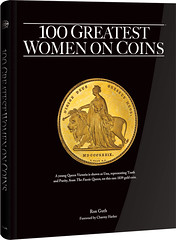
Another interesting selection was Queen Marie Antoinette at Number 40. She reigned, along with her husband King Louis VVl, from 1774 until their executions in 1792.
Ken Spindler writes:
King Louis was Louis XVI, and each was guillotined (9 months apart) during 1793.
By coincidence, last week at the symphony they (San Diego Symphony) played Symphonie fantastique by Hector Berlioz, in which a lovesick composer, drowning his sorrows by using opium, dreams that he murdered the woman who spurned him, and he is guillotined, depicted in the music when his last remembrance of his beloved is suddenly "cut off" - with a bang. The last scene of the opera Dialogues of the Carmelites (Francis Poulenc) ends with all (but 2?) of the nuns getting guillotined one by one.
To read the earlier E-Sylum article, see:
BOOK REVIEW: 100 GREATEST WOMEN ON COINS
(www.coinbooks.org/esylum_v19n09a08.html)
Bookbinder Thanks
Jan Monroe writes:
I want to thank everyone who has submitted recommendations for book binders.
To read the earlier E-Sylum articles, see:
NOTES FROM E-SYLUM READERS: FEBRUARY 21, 2016 : Bookbinder Recommendations
(www.coinbooks.org/esylum_v19n08a12.html)
NOTES FROM E-SYLUM READERS: FEBRUARY 28, 2016 : Bookbinder Recommendation: Sam
Ellenport (www.coinbooks.org/esylum_v19n09a17.html)
Medals of the J.F. Newman Company
Regarding the First Columbian Half Dollar, Rich Hartzog writes:
 Some decades ago I bought several dozen over-runs and other medals and badges from the J.F. Newman company. In that lot was an example of
the New Centre Market medal. I found it and the others in my hoard just a few days ago. Does anyone collect Newman issued material?
Some decades ago I bought several dozen over-runs and other medals and badges from the J.F. Newman company. In that lot was an example of
the New Centre Market medal. I found it and the others in my hoard just a few days ago. Does anyone collect Newman issued material?
To read the earlier E-Sylum article, see:
THE NEW CENTRE MARKET MEDAL (www.coinbooks.org/esylum_v19n09a22.html)
Julius Caesar and Leap Days

Bob Fritsch writes:
NASA's Astronomy Picture of the Day for February 29th featured a coin of Julius Caesar and explained how he invented Leap Day. Pretty cool to have an ancient coin featured on a popular website, which has some spectacular shots of our cosmos.
Explanation: Today, February 29th, is a leap day - a relatively rare occurrence. In 46 BC, Julius Caesar, featured here in a self-decreed minted coin, created a calendar system that added one leap day every four years. Acting on advice by Alexandrian astronomer Sosigenes, Caesar did this to make up for the fact that the Earth's year is slightly more than 365 days. In modern terms, the time it takes for the Earth to circle the Sun is slightly more than the time it takes for the Earth to rotate 365 times (with respect to the Sun -- actually we now know this takes about 365.24219 rotations).
So, if calendar years contained 365 days they would drift from the actual year by about 1 day every 4 years. Eventually July (named posthumously for Julius Caesar himself) would occur during the northern hemisphere winter! By adopting a leap year with an extra day every four years, the calendar year would drift much less. This Julian Calendar system was used until the year 1582 when Pope Gregory XIII provided further fine-tuning when he added that leap days should not occur in years ending in "00", unless divisible by 400. This Gregorian Calendar system is the one in common use today.
To read the complete article, see:
Astronomy Picture of the Day (http://apod.nasa.gov/apod/ap160229.html)
More on the Great Tea Race Coin
Yossi Dotan writes:
Under the heading "2016 COOK ISLANDS GREAT TEA RACE OF 1866 TWO DOLLAR COIN" in The E-Sylum of Feb. 28, 2016 you show a coin with a ten-dollar face value. You took the images from the Coin Invest web page http://www.coin-invest.li/Coins.aspx#!Keyword=tea+race&ProductID=1211, which you mentioned.
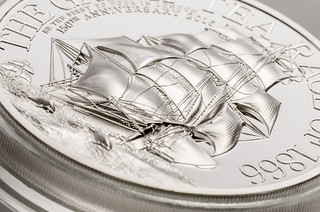 At the bottom of the above web page you will see that the collection consists of two coins, both .999 silver, both with a diameter of 38.61
mm and both in proof: a 2-dollar coin that weighs 8 g with an issue of 2500 pcs. (article 27664 or, in the fact sheet, article 27675) and a 10-dollar
coin that weighs 2 oz. with an issue of 999 pcs. (56.7 g, article 27676). Probably the information concerning the high relief relates to the
10-dollar coin only, which is more than seven times thicker that the 2-dollar coin.
At the bottom of the above web page you will see that the collection consists of two coins, both .999 silver, both with a diameter of 38.61
mm and both in proof: a 2-dollar coin that weighs 8 g with an issue of 2500 pcs. (article 27664 or, in the fact sheet, article 27675) and a 10-dollar
coin that weighs 2 oz. with an issue of 999 pcs. (56.7 g, article 27676). Probably the information concerning the high relief relates to the
10-dollar coin only, which is more than seven times thicker that the 2-dollar coin.
The images given by Coin Invest for the $2 coin are the obverse of the $10 coin and the reverse for the $2 coin. The fact sheet shows the obverses of both coins.
To read the earlier E-Sylum article, see:
2016 COOK ISLANDS GREAT TEA RACE OF 1866 TWO DOLLAR COIN
(www.coinbooks.org/esylum_v19n09a32.html)

FUGIO CENT DIES USED AS PAPERWEIGHTS
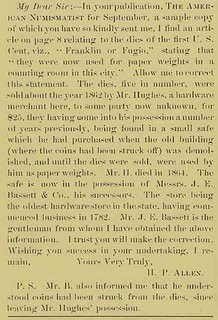 My Dear Sir ;—In your publication, The American Numismatist for September, a sample copy of which you have so kindly sent me, I find an
article on page 8 relating to the dies of the first U. S. Cent, viz., “ Franklin or Fugio,” stating that “ they were now used for paper weights in a
counting room in this city.” Allow me to correct this statement.
My Dear Sir ;—In your publication, The American Numismatist for September, a sample copy of which you have so kindly sent me, I find an
article on page 8 relating to the dies of the first U. S. Cent, viz., “ Franklin or Fugio,” stating that “ they were now used for paper weights in a
counting room in this city.” Allow me to correct this statement.
The dies, five in number, were sold about the year 1862 by Mr. Hughes, a hardware merchant here, to some party now unknown, for $25, they having come into his possession a number of years previously, being found in a small safe which he had purchased when the old building (where the coins had been struck off) was demolished, and until the dies were sold, were used by him as paper weights. Mr. H. died in 1864.
The safe is now in the possession of Messrs. J. E., Bassett & Co., his successors. The store being the oldest hardware store in the
state, having commenced business in 1782. Mr. .J. E. Bassett is the gentleman from whom I have obtained the above information. 1 trust you
will make the correction. Wishing you success in your undertaking, I remain, Yours Very Truly,
H. P. Allen.
P. S. Mr. B. also informed me that he understood coins had been struck from the dies, since leaving Mr. Hughes’ possession.
To read the complete article, see:
http://www.archive.org/stream/americannumismat01n3leal#page/22/mode/2up

AMERICAN REGULATED GOLD PIECES
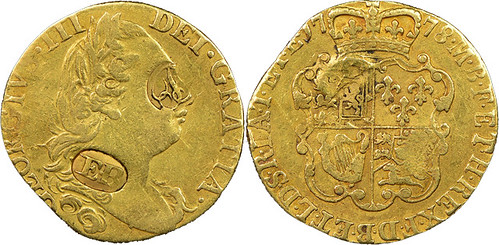
The Numismatic Guaranty Corporation reports it certified six rare early American regulated gold pieces that were submitted during the New York International Numismatic Convention. Regulated gold coins represent an important era in United States coin circulation history.
Before the U.S. began minting coins, foreign coins were used in commerce. In order to facilitate their circulation, the coins were clipped or had a plug added, regulating them to a specific weight. They were then stamped with a dollar value and the hallmark of the assayer.
Five of the submitted coins bear the hallmark of Ephraim Brasher, a famous gold and silversmith. He is well known for producing the Brasher doubloon, the first gold coin minted for the United States. Joseph Richardson, Jr. stamped the other regulated gold piece.
NGC states the dealer who sent the coins in noticed the interesting countermarks and was unaware of their rarity.
To read the complete article, see:
NGC slabs regulated gold
(www.numismaticnews.net/article/ngc-slabs-regulated-gold)
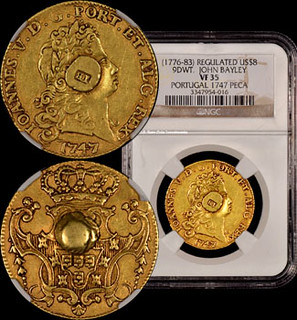
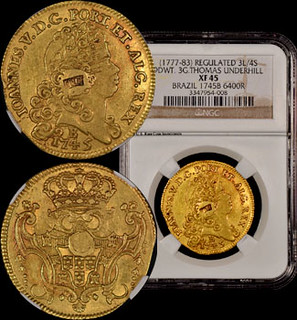
Regulated Gold Coins - Article I, Section 8, Clause 5 of the Constitution gives Congress the power to “coin money, regulate the value thereof, and of foreign coin, and fix the standard of weights and measures.” This power was necessary in post-Revolutionary times because gold coins from many countries of the world circulated as legal tender in the United States. They were valued for their gold content not as specie. This cacophony of coins of the world would be an obvious source of confusion in domestic and foreign commerce. Coins from Brazil, Portugal, Spain, France, and England all circulated concurrently. However, each had a different weight and fineness making trade extremely inconvenient.
The problem was first dealt with in colonial times, when coins were “regulated.” This practice continued after Independence. A goldsmith or silversmith would drill a coin and add gold in the form of a plug to increase its weight. If it was then overweight, he would clip and/or file its edge. Thus, coins were “regulated” to certain standards. The plugs that were added were then stamped with a hallmark identifying the regulator who guaranteed the gold content of the piece. Regulators, who were also jewelers and highly thought of members of the community, included John Bayley, John Burger, John David Jr., Lewis Feuter, Myer Myers, Thomas Pons, Thomas Underhill, and William Hollingshead. However, none was so prominent and famous in numismatic circles as Ephraim Brasher.
When a gold coin circulates, its weight can change. Honest wear as well as dishonest practices cause changes in weight and therefore value. Coins were clipped and sometimes a bag of coins was “sweated.” It would be shaken and the resulting dust and other gold residue would be accumulated and later sold. So in addition to coins coming from different countries, they might have had to be regulated because of their diminished value as a result of wear, clipping, or sweating.
Regulated coins have been found in collections of famous collectors and numismatists. These include Virgil M. Brand, Louis Eliasberg, John J. Ford Jr., John Work Garrett, Waldo Newcomer, and John L. Roper. Edward Roehrs had an excellent collection of regulated coins that was auctioned in 2010 at the ANA Boston World’s Fair of Money.
For more information, see:
REGULATED GOLD - REGULATED GOLD COINS -
COLONIAL AMERICAN COINS (www.usrarecoininvestments.com/coin_info/colonial_american
_coins_regulated_gold.htm)

CONTINENTAL CURRENCY PRINTING PLATES DONATED TO MINT
Wm. C. Armor Esqr.
Harrisburg, Pa.
Dear Sir
I have to thank you for two engraved plates used in making the Continental
currency; to be placed in the Cabinet of the Mint.
Very respectfully,
James Pollock
Director
per H.C. Hickok
Director’s Clerk
Bob adds:
I was unaware that engraved plates were used for the Continental currency and have not found any information on the plates beyond the letter. The letter is not actually signed by Director Pollock but rather his chief clerk, Henry C. Hickok.
THE PIRATES TREASURE CALIFORNIA GOLD SET
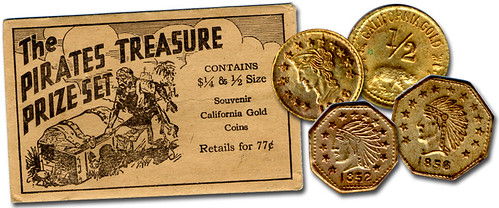
Over the decades in my professional capacity as a catalog writer I have had the opportunity to catalog some of the finest collections ever assembled of California Small Denomination or Fractional gold coins, including the Texas Collection and the Jay Roe Collection. Whenever a collection of California Fractional gold coins appears for auction there is included, more often than not, a group of California “charms” that closely resemble California Fractional pieces, but there the similarities stop. These charms are dated typically in the Gold Rush era though they were produced late in the 19th and early to mid-20th centuries. Most importantly, however, was the fact that they had no denomination such as CENTS or DOLLAR as found on the genuine pieces. I often wondered how these little charms, far more numerous than the genuine California pieces, made it into so many collections. How were they distributed? Were they for sale by jewelers who produced them to demonstrate engraving skills? Did they sell at coin shows? How much did they cost when new? Were they available to firms for promotional gimmicks?
A recent find on an Internet bidding site partly answered some of my long-time queries. My latest exonumia purchase is a small 3.5 inch X 2.25 inch manila envelope with a depiction of a pirate on a tropical shore opening a treasure chest. THE / PIRATES TREASURE / PRIZE SET appears in boldface letters above the beach scene on three lines. To the right of the pirate the envelope reads CONTAINS / $1/4 & $½ SIZE / SOUVENIR / CALIFORNIA GOLD / COINS / RETAILS FOR 77C on six lines. The contents, all Mint State, include an “1856” Liberty Head Round 25C, an “1852” Liberty Head Round 50C, an “1852” Indian Head Octagonal 25C, and an 1856 Indian head Octagonal 50C. All are nicely toned and fully brilliant, the toning no doubt from the glassine envelope inside the manila holder. Who made these particular charms is unknown to me, but the packaging must have caught the eye of many youngsters back when offered. It sure caught my adult eye and I couldn’t wait to add this Pirates Treasure of California Gold charms to my collection. I wonder how many kids paid 77C for the honor of owning one of these pirate packages. Here in 2016, I had to pay $10, postage included, and I would pay that amount over and over again for more pirate treasure California Fractional charms.
To read the complete article, see:
Of Pirates’ Treasures and California Gold Charms (www.stacksbowers.com/NewsMedia/Blogs/TabId/780/ArtMID
/2678/ArticleID/65600/Of-Pirates%E2%80%99-Treasures
-and-California-Gold-Charms.aspx)
THE BOOK BAZARRE
SOME MORE HALF DIME TOKENS
Nicholson's, St. Louis, MO
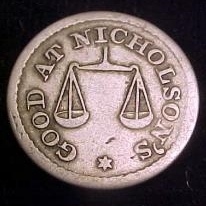
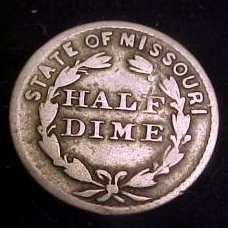
GOOD AT NICHOLSON'S
STATE OF MISSOURI / HALF / DIME
TC-352969; Missouri NIA; Wright 758 *** 15.31mm*** David Nicholson, born in Scotland in 1814, moved to Canada and then in 1838 to St. Louis. By 1850 he operated one of, if not the largest grocery businesses in the city from his store at Number 1 Fourth Street. He was still in business in 1870, and died in 1880.
To read the complete Token Catalog listing, see:
Saint Louis, Missouri (Independent City), U.S.A.
J. B. Wilson's, St. Louis, MO
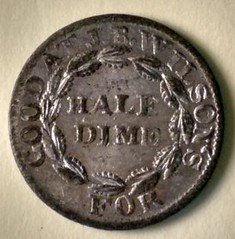
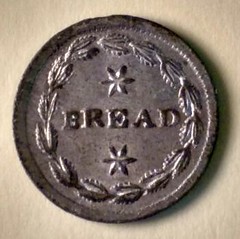
GOOD AT J.B. WILSON'S / HALF / DIME / FOR
BREAD
TC-353092; Missouri *** erronersly listed as cwt in 460y-4e james b. wilson 1853-1857; auction record $880+ 12-03 pc&a, joe levine*** Image courtesy of Mark Borckardt and Heritage Auctions Contributed by: Numisman
To read the complete Token Catalog listing, see:
Saint Louis, Missouri (Independent City), U.S.A.
Wm. Hisgen's Billiard Hall, Petersburg, IN
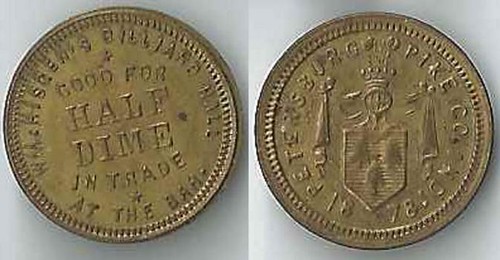
WM. HISGEN'S BILLIARD HALL / GOOD FOR / HALF / DIME / IN TRADE / AT THE BAR.
PETERSBURG PIKE CO. IND: / (Crested, Mantled Shield of Arms) / 18 78
TC-439513; Gross PETERSBURG 1b
To read the complete Token Catalog listing, see:
Petersburg, Indiana (Pike County), U.S.A.
Wm. Hisgen's Billiard Hall, Petersburg, IN
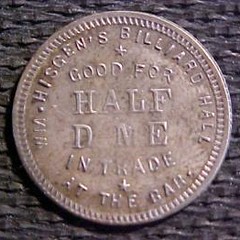
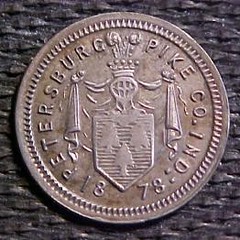
WM. HISGEN'S BILLIARD HALL / GOOD FOR / HALF / DIME / IN TRADE / AT THE BAR.
PETERSBURG PIKE CO. IND: / (Crested, Mantled Shield of Arms) / 18 78
TC-283411; Rulau In-Pt 3; Wagaman P-2200a *** 15.64mm
To read the complete Token Catalog listing, see:
Petersburg, Indiana (Pike County), U.S.A.
Although I might not be the one to write the article or book on the subject, I do have nice, high grade examples of several half-dime-explicit and half-dime-implicit tokens, including the two examples listed and pictured in the 1931 Valentine reference on U.S. half dimes, plus several others. I was able to acquire a few examples from the late Steve Tanenbaum, but more significantly I was able to learn much interesting information from him. He was certainly an expert in his field. I would be willing to assist in writing an article on the subject, and to make my examples available for photography (I am unable to provide my own photographs of my tokens). Anyone interested in working on such a project can contact me at: mrhalfdime@aol.com.
To read the earlier E-Sylum article, see:
WANTED: RESEARCH ON HALF DIME TOKENS
(www.coinbooks.org/esylum_v19n09a15.html)
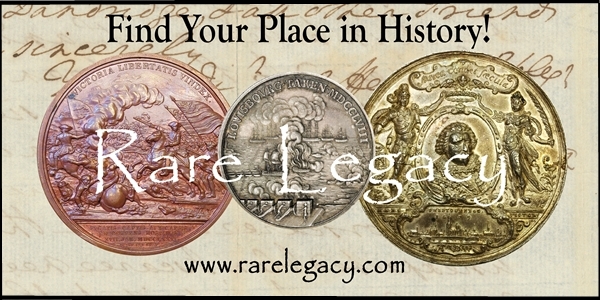
WHERE ARE THE PEALE REPORT DRAWINGS?
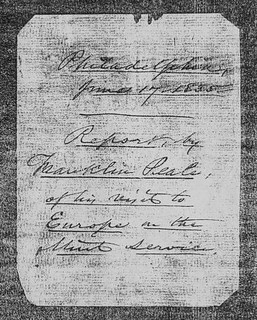 Now that the manuscript Peale Report is in the Newman Numismatic Portal we must ask the question: Where are the Peale Report drawings?
Now that the manuscript Peale Report is in the Newman Numismatic Portal we must ask the question: Where are the Peale Report drawings?
After many conversations with fellow Rittenhouse member Craig Sholly on early U..S. Mint technology we both agreed on the importance of the improvements brought about by Franklin Peale. We are fortunate Peale wrote a report of a two-year trip to European mints where he learned the latest technology of coin making.
On June 17, 1835 Peale presented his 272-page report to Mint Director Samuel Moore who apparently gave Peale the green light to install the equipment and methods outlined in his Report to improve what the Philadelphia Mint needed to bring it up to match European mints.
Craig had been to the Philadelphia National Archives and obtained a photocopy of the Peale Report. He duplicated this for me. We both poured over our copies but we were like six-year olds trying to read for the first time. We had to read the uniform but unfamiliar script one word at a time, often one letter at a time.
I resolved to transcribe it no matter how long it took. I accomplished 46 pages before abandoning the project, Even so, there are several instances of words still unknown.
I wanted to see the original. Would I be able to read it easier? I traveled to Philadelphia after making arrangements to have the document retrieved from storage. On arrival the following day custodians wheeled in a cart and handed me the Peale Report. THE Peale Report. This was the original!
This was the Holy Grail of American Mint technology! I have examined thousands of documents in dozens of archives before. I was no neophyte. But my body tingled at what I held in my hands.
Page after page contained that familiar Peale script. Then I realized the drawings were missing from the Report. It made reference to such drawings but they were nowhere to be found. Apparently they had disappeared years before.
In addition to that question. Since many researchers had examined it I have a further question: A Catholic Nun had examined the Report and wrote an article about it. Where was that article published? I vaguely recall this, but have lost the citation.
In last week’s E-Sylum a call went out for volunteers to transcribe the Peale report. Whoever accomplishes this will earn the gratitude of a large number of numismatists interested in early U.S. Mint technology.
To read the earlier E-Sylum article, see:
CAN YOU READ FRANKLIN PEALE’S HANDWRITING?
(www.coinbooks.org/esylum_v19n09a11.html)
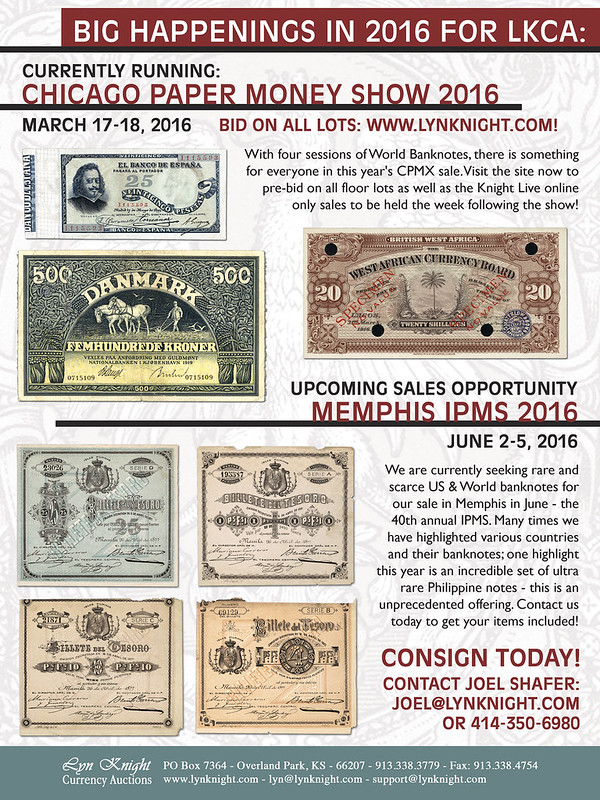
"UFO" JETON RESURFACES IN POPULAR MEDIA
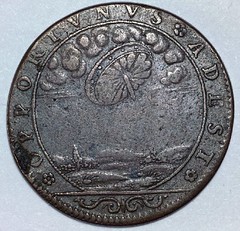
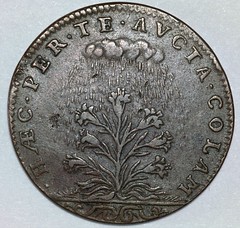
A 17th century French token has UFO hunters claiming 'absolute proof' of UFO sightings hundreds of years ago.
The ancient jeton, a coin-like object used for counting, depicts an unusual circular entity that looks remarkably like a flying saucer.
Some have even argued that this represents the Biblical Ezekiel's wheel, which they claim is the Bible's own tale of a UFO encounter.
The perplexing object has spurred theories dating back decades, brought to life again by its recent mention on UFO Sightings Daily.
Skeptics over the years have offered a slew of possible explanations, arguing that it looks like a drifting mushroom or flower, or even a shield.
Some even say it bears an uncanny resemblance to the towers built for the World's Fair, made famous as alien ships in the Men in Black film.
Scott C. Waring, editor of UFO Sightings Daily, speculates that the token is proof of UFO sightings so frequent in ancient France that they were inscribed on coins.
'I've been looking for one of these off and on for a few weeks. It looks really amazing and is absolute proof that in the 1600s the French witnessed enough UFO sightings to decide to put some of what they saw on coins,' writes Waring.
'This is a French jeton minted somewhere between 1856 to 1680, a coin-like educational tool that was commonly used to help people count money, or sometimes used as a money substitute for playing games.
'It is about the size of a U.S. quarter-dollar and similar to thousands of other jetons with different religious and educational designs that were produced and used in Europe during the 16th and 17th centuries.
To read the complete article, see:
Does
this mysterious 'flying saucer' French coin from the 1680s show an alien UFO visiting Earth?
(www.dailymail.co.uk/sciencetech/article-3475501/Does-mysterious-flying-saucer-French-coin-1680s-alien-UFO-visiting-Earth.html)
Im 2005 Philip Mernick wrote:
"The item itself was correctly described as a jetton and is listed as F12528 in Collection Feuardent, Jetons et Mereau Depuis Louis IX jusqu’a la fin du Consulat de Bonaparte by F. Feuardent, published by Rollin et Feuardent, Paris, 1913. It would appear to be a version of F12527 which is coupled with a portrait of Louis XIV and is dated 1656. Feuardent describes the “UFO” as “un bouclier celeste” a celestial shield. The depiction of a shield on the jeton is similar to one illustrated in Juan de Borja, Empresas morales, first published Prague 1581 (illustration from Brussels 1680 edition). It is there described as representing a timely occurrence. It could refer to an event in the war against Spain or possibly to the return of Mazarin in 1653. The other side symbolises the revival of France (illustrated by a lily plant being refreshed by rain from the sky). Information originally supplied by Robert Thompson."
To read the complete article, see:
Is this proof UFOs visited Earth throughout
history? Alien hunter spots mysterious carving on ancient coin
(www.mirror.co.uk/news/weird-news/proof-ufos-visited-earth-throughout-7492890)
To read the earlier E-Sylum articles, see:
NOSTRADAMUS' POCKET PIECE, PERHAPS? (www.coinbooks.org/esylum_v08n05a24.html)
MORE ON THE UFO TOKEN (www.coinbooks.org/esylum_v08n13a10.html)
"UFO" JETON ARTICLE DISAPPEARS FROM THE WEB - CONSPIRACY, PERHAPS?
(www.coinbooks.org/esylum_v09n38a05.html)
THE U.S. MINT'S PALLADIUM BULLION COIN
A few years ago, there was a push for the U.S. government to authorized the mintage of a palladium bullion coin. The U.S. Mint produces bullion coins in the three other precious metals (gold, silver, and platinum) but not palladium.
So in 2010, President Obama signed The American Eagle Palladium Bullion Coin Act of 2010 into law. Its intent:
To authorize the production of palladium bullion coins to provide affordable opportunities for investments in precious metals, and for other purposes. The law called for, “A $25 coin of an appropriate size and thickness, as determined by the Secretary, that weighs 1 troy ounce and contains .9995 fine palladium.”
The coin's design would, “bear designs on the obverse and reverse that are close likenesses of the work of famed American coin designer and medallic artist Adolph Alexander Weinman–”
The bill goes on to state the specifics of the design:
- the obverse shall bear a high-relief likeness of the ‘Winged Liberty’ design used on the obverse of the so-called ‘Mercury dime’;
- the reverse shall bear a high-relief version of the reverse design of the 1907 American Institute of Architects medal; and
- the coin shall bear such other inscriptions, including ‘Liberty’, ‘In God We Trust’, ‘United States of America’, the denomination and weight of the coin and the fineness of the metal, as the Secretary determines to be appropriate and in keeping with the original design.
Here is the obverse and reverse of the coins the law is referring to...
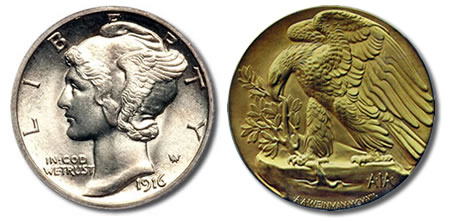
As part of the law, however, a marketing study was to be first conducted to determine if there was, in fact, a large enough market demand for palladium bullion investments. The general purpose of the study was to ensure that palladium bullion (and palladium numismatic coins) could be minted and issued at no net cost to taxpayers. The United States Mint retained CPM Group LLC to produce the study. CPM Group’s main conclusions were, as they are stated on the U.S. Mint's website:
It is unlikely that there will be sufficient demand for a U.S. Mint palladium bullion coin and such a program would most likely not be possible to undertake profitably
So a U.S. palladium bullion coin is not happening. Nevertheless, I asked one of the resident graphic designers here at Angel Publishing if he could create an image of what this palladium coin might look like.
Here's what he came up with...
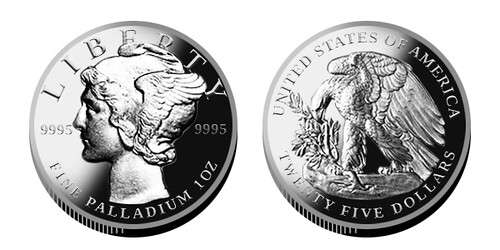
To read the complete article, see:
What Could Have Been the
U.S. Mint's Palladium Bullion Coin
(www.energyandcapital.com/articles/what-could-have-been-the-us-mint-palladium-bullion-coin/5352)

OBJECT OF INTRIGUE: CONFEDERATE CURRENCY
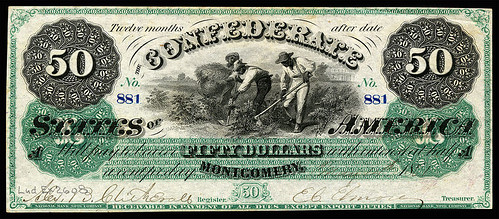
American banknotes today feature mighty presidents of yore, grand buildings of the nation’s capital, and eagles. In 1861, the banknote imagery of choice included brand-new railroads, Greek goddesses, and slavery.
When Deep South states seceded to form the Confederacy in early 1861, they started issuing their own currency. The first series of Confederate States dollars was introduced in April 1861, on the eve of the Civil War.
Each bill was stamped with a mishmash of imagery intended to inspire, but none more strikingly so than the $50 and later $100 notes, which depicted, among other vignettes, a trio of slaves working in a cotton field.

Romanticized depictions of slavery on banknotes were not a new concept at the time. Individual banks in southern states had been putting images of slaves working the fields on their bills since the 1850s. (The 19th century was the height of the Free Banking Era, a time of unregulated, decentralized economics in which individual banks could issue their own currency.)
With the dawn of the Civil War, however, Confederate bank notes became scraps of Southern hope in the fight to retain slavery. The initial 1861 series was followed by six more sets of notes, with the final series issued in 1864. Each bill was a pocket-sized piece of Confederate propaganda that could be spread far and wide—within the southern states, and up into the Union.
In putting images of slaves hoeing cotton fields, loading carts, or carrying bags of corn on its currency, the Confederacy affirmed its unashamed reliance on slavery as a fundamental part of the Southern economy. Furthermore, as Louisiana State University journalism professor Jules d’Hemecourt put it, stamping the cash with such imagery alongside mythological Greek gods and goddesses made a dogged statement that slavery “would continue to exist in perpetuity, protected by law and sanctioned by tradition, and all but divinely ordained in iconography.”
There are a few places where these banknotes have been particularly well preserved. The Boston Athenaeum currently holds over 6,000 pieces of Confederate paper currency in its collection, with much of it viewable online.
The images also live on in remixed forms. South Carolina artist John W. Jones—himself a descendent of slaves—has created a series of colorful acrylic paintings based on the Confederate banknotes' slavery vignettes, entitled "The Color of Money." In his words, the images on the currency are “a visual smoking gun that documents how much free slave labor enriched America.”
To read the complete article, see:
Object of Intrigue: Confederate Currency
(www.atlasobscura.com/articles/object-of-intrigue-confederate-currency)
3D PRINTING IMPOSSIBLY HIGH RELIEF PRECIOUS METAL COINS
 The value of 3D printing speaks the highest volumes when it is used to produce the coveted ‘impossible objects’. Direct Precious Metal 3D
printing has best demonstrated this in the jewelry sector where the process has opened up unique design and weight-loss possibilities. So what
happens when you introduce that level of innovation to a completely different traditional industry like coin making?
The value of 3D printing speaks the highest volumes when it is used to produce the coveted ‘impossible objects’. Direct Precious Metal 3D
printing has best demonstrated this in the jewelry sector where the process has opened up unique design and weight-loss possibilities. So what
happens when you introduce that level of innovation to a completely different traditional industry like coin making?
Cooksongold’s Direct Precious metal 3D printing has already been applied to create several unique pieces of jewelry, which were highlighted in the recent PRECIOUS Project, a £471,000 research and development project into the additive manufacture of precious metal jewelry.
Cooksongold, part of the Heimerle + Meule Group, has a long history of manufacturing precious metal products for the jewelry and watchmaking industries. Last year in collaboration with EOS, the company launched the Precious M 080, an advanced manufacturing technology that allows users to create complex jewelery and watch components in a range of Advanced Precious Metal Powders; 18k gold, 950 Platinum and 925 silver.
In its most recent project the technology was utilised to tackle a different kind of industrial manufacturing – at the mint. Cooksongold already supplies coin blanks to many mints around the world, which then strike their own images onto the coins. With that, the precious metals supplier decided to set itself the challenge of printing the world’s first truly 3D image directly onto the face of an existing blank coin using a different alloy.
To achieve this, the build platform was first milled to house the existing 18k yellow gold coin blank. Using a CAD image of the “crown” design, the image was 3D printed in 20-micron layers using 500g of 18k white powder directly onto the coin. The precious metal 3D printing process melted the powder directly to the surface of the coin ensuring strong adhesion between the metals. Utilising the unique production process meant it was possible for the coin to have undercuts and display a truly 3D image that is simply not possible using traditional stamping techniques.
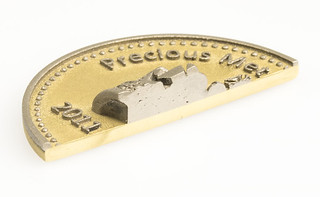
The build time took just one hour to complete and then a further 30 minutes to post process. Due to the lack of support structures, the coin was removed with ease and post-processed using conventional automated and hand polishing techniques. The finished piece weighed 44.6g. By splitting the coin blank down the middle, the team were able to confirm that their first effort demonstrated “fantastic adhesion” between layers of the two alloys.
Following the success of the first case study, Cooksongold decided to experiment with the possibility of printing on BOTH sides of a fine gold coin, only this time using platinum.
Using a similar process, the build platform was milled to house the gold 28.1mm diameter, 2.00mm thick coin blank, plus the 5.3mm high relief of the “crown” image. Using a CAD file the crown image was 3D printed onto the back of the coin and then repeated on the reverse. With minimal finishing, the entire process took 140 minutes to complete.
Along with the ability to combine two metals, the second innovation shown in these studies is the freedom to produce a 3D image with a much higher relief than conventional stamping processes allow. Whilst a standard coin features a shallow relief of around 1.00 or 2.00mm, Cooksongold were able to achieve a relief of 5.3mm with 3D printing.
Cooksongold recently showcased the results of these prints to at the world’s largest coin fair, World Money Fair in Berlin. Members of the coin making industry were particularly excited by the potential to print hollow structures directly onto the surface of a blank therefore reducing weight and material consumption dramatically.
To read the complete article, see:
Licence to 3D Print Money
(www.tctmagazine.com/3D-printing-news/licence-to-3d-print-money/)
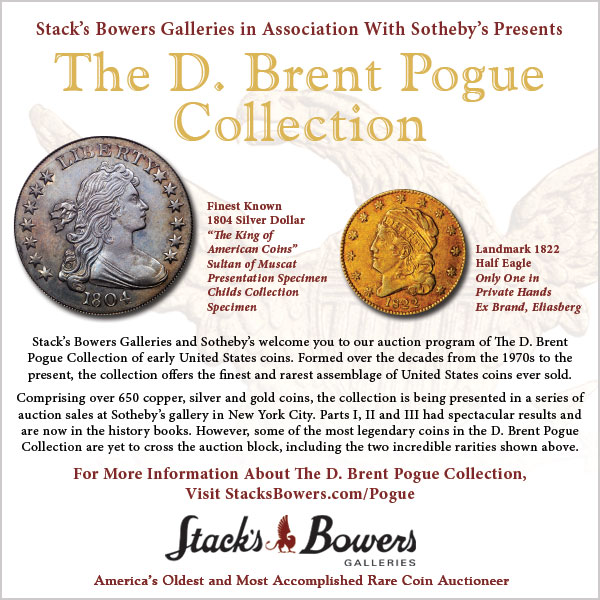
SPINK TO SELL STEWARTBY COLLECTION OF ENGLISH COINS
The Academic Collection of English coins assembled by Lord Stewartby over a long and very active lifetime will be dispersed by Spink in a series of auctions over the coming months. The first part containing Anglo-Saxon and Norman coins, taking place on the 22nd March 2016, will give collectors the opportunity to acquire some extremely rare pieces at affordable prices. Many of the coins were also acquired from some of the great collections of the past so they come with impressive provenances; in his own words, Lord Stewartby said: "The only sad thing about a collection such as this is that it would be impossible for an interested amateur, as I was, to put it together today".
An interest in coinage was developed at a young age when, as a small boy, clinging to his mother's hand in war-torn Barnet, he noticed a copper coin in a jar on the counter of a grocer's shop with two heads on it and recognised it as being from the reign of William & Mary. And thus began his lifelong interest in, and contribution to, numismatics.
The sale immediately kicks off with a superb gold Thrymsa of Eadbald of Kent, the first gold coin issued in the name of an English king, extremely fine and extremely rare, one of only seven examples. In 1998, new finds enabled the obverse inscription on the coin to be confirmed as AVDVARLD REGES, and translated as 'of King Audvarld'. The name 'auduarldus' appears in Bede's Historia Ecclesiastica completed in 731 in which he wrote about king Eadbald of Kent.
Eadbald succeeded Aethelberht as king of Kent in 616. According to Bede, after his accession Eadbald fell afoul of the young Christian Church, ejecting its Bishops and incurring the wrath of the Church for '. . . he took his father's (second) wife as his own.' Whatever Eadbald did, this situation did not last for he repented and was duly baptized, rejecting his wife and thereafter favouring the Church within his kingdom. These events reflect the conflict and confusion amongst the Anglo-Saxon elite at this time as Christianity sought to assert itself over the Pagan religion. This struggle is best known from the mix of Pagan and Christian artefacts in the Sutton Hoo ship burial, which is contemporaneous to Eadbald and this coin. As to the date of these named Thrymsas or Shillings of Eadbald, the presence of Christian iconography dates them to after his conversion and a date to between 620 and 635 is thought appropriate.
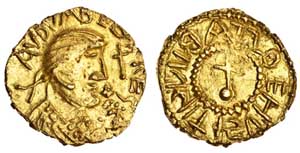
Lot 1, estimated: £12,000-15,000
From such a hectic relationship with Christianity, there are also truly stunning coins that show the later harmony and acceptance in the country. Lot 72 is an excellent example of such as a Penny commissioned by the Archbishops of Canterbury, Jaenberht (766-92), with King Offa as overlord, a good example of this rare issue and extremely rare.
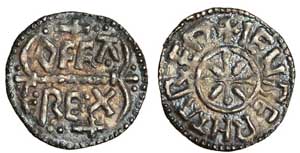
Lot 72, estimated: £3,000 - 4,000
From the Norman section is a fantastic William I Penny, lot 321, a Two sceptres type bearing a very stern-faced resemblance of the conquering King. An extremely rare coin.
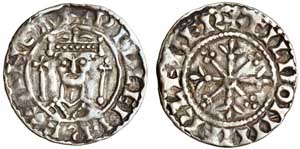
Lot 321, estimated: £2,500 - 3,000
For collectors of early English hammered coins, here truly is a sale that has 'something for everyone'.
To read the complete article, see:
Anglo-Saxon
and Norman Coins to Battle it out in the Spink Auction Room
(/www.spink.com/press-releases/anglo-saxon-and-norman-coins-to-battle-it-out-in-the-spink-auction-room.aspx/?id=coins&year=2016)

SOTHEBY’S 1913 SALE OF ARTHUR CONAN DOYLE’S COINS
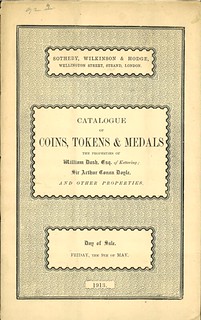
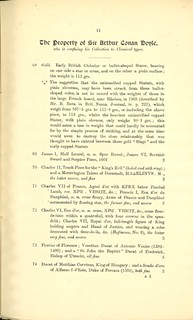
A few weeks ago we published a HolmeWork assignment regarding a New York Times news items regarding Sotheby’s auctioning off some of Arthur Conan Doyle’s coin collection in 1913. [By the way, we’re going to act like we never screwed up that original post (now corrected) by referencing Christie’s instead of Sotheby’s. That’s right – it never happened.] Wayne Homren, Editor of The E-Sylum passed our plea onto his readers and had several comments and new information for us to follow-up on.
Officially, the auction was conducted by Sotheby, Wilkinson & Hodge at 1PM at their offices of 13 Wellington Street, W.C. Lots were able to be viewed during the two days prior to the sale. The auction consisted of 175 lots, 22 of which were from Sir Arthur Conan Doyle’s coin collection.
Professor Ted Buttrey of the Fitzwilliam Museum in Cambridge offered up this summary of those 22 lots: “These 22 lots are a gathering of 421 coins, mostly not described and not worth describing. Scattered British from Anglo-Saxon to Charles II, some continental (gold of Charles VI and VII of France).”
Buttrey also mentioned that the Fitzwilliam Museum has a copy of the auction catalog that is annotated with the sales price and purchasers. We have requested and received scans of the three pages of Sir Arthur’s material, which we will feature in a future post.
The 22 lots from the Doyle collection netted under £28 or just over $136 in 1913 dollars. Commentator Peter Preston-Morley offered up that this equates to £2,850 or $4,075 in today’s economy.
Sotheby’s mentions at the start of Sir Arthur’s lots that Doyle “is confining his Collection to classical types.” This is probably referring to the ancient Greek and Roman coins that Doyle collected and were sold by the New York firm of Manfra, Tordella and Brookes in 1968, which we discuss in our next post.
Thanks to David Pickup, Professor Ted Buttrey and Peter Preston-Morley for their comments to our original posting and setting us upon the proper path.
Special Thanks to David Hill, Librarian of the American Numismatic Society for providing us with the scans of the auction catalog.
To read the complete article, see:
Sotheby’s May 9, 1913 Cataloging
of Arthur Conan Doyle’s Coins (http://fourthgarrideb.com/2016/03/sothebys-may-9-1913-cataloging-of-arthur-conan-doyles-coins/)
To read the earlier E-Sylum articles, see:
NOTES FROM E-SYLUM READERS: OCTOBER 12, 2014 : Query: Coins Pedigreed to Sir
Arthur Conan Doyle Sought (www.coinbooks.org/esylum_v17n42a07.html)
QUERY: SOTHEBY'S SIR ARTHUR CONAN DOYLE CATALOG SOUGHT
(www.coinbooks.org/esylum_v19n08a19.html)
MORE ON COINS COLLECTED BY SIR ARTHUR CONAN DOYLE
(www.coinbooks.org/esylum_v19n09a29.html)

MTB’S 1968 PRICE LIST OF ARTHUR CONAN DOYLE’S ANCIENT COINS
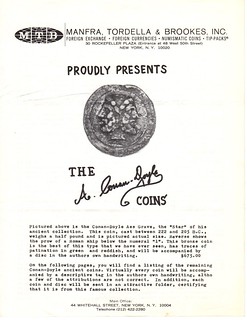 In October 2014, we published our first HolmeWork assignment, asking for assistance in locating the price list that Manfra, Tordella and
Brookes issued in 1968 when they sold the ancient coin collection of Sir Arthur Conan Doyle. We now have copies of a 6 page listing that MTB
produced, featuring ancient Greek and Roman coins from Doyle’s collection. We also have a scan of the cover of MTB’s 1968 Christmas List #14, which
references how quickly the coins from Doyle’s collection sold.
In October 2014, we published our first HolmeWork assignment, asking for assistance in locating the price list that Manfra, Tordella and
Brookes issued in 1968 when they sold the ancient coin collection of Sir Arthur Conan Doyle. We now have copies of a 6 page listing that MTB
produced, featuring ancient Greek and Roman coins from Doyle’s collection. We also have a scan of the cover of MTB’s 1968 Christmas List #14, which
references how quickly the coins from Doyle’s collection sold.
BUT WAIT, THERE’S MORE ….. MAYBE …..
This is pure speculation on your Editor’s part, but there are several indicators that make us think there was an earlier listing than the one we show in this post. Why do we think this way?
In Tom Haney’s September 8, 1968 New York Times column (we now have a scan of that column you can view), he mentions that “The items have been cataloged and will be offered in the company’s new fall price list.” No where on the price list we are showing does it mentions that it is the fall price list. It seems logical that he would have the price list in hand as he was writing his article – if he had the price list we are showing where would he have gotten the words “fall price list?” In addition, our last scan below is the cover letter of the Christmas list #14, so it seems logical that they would have had an earlier fall price list.
Haney starts his column by mentioning “More than 500 items are in the collection of the late Sir Arthur Conan-Doyle …” yet the price list we have below has just over 200 coins listed for sale. On page 4 of the listing below, MTB does mention “there are many coins of lesser grades and/or commoner types” available for purchase, but would that account for the 300 coin discrepancy?
On the cover page, illustrated above, of the price list we have is the quote “a listing of the remaining Conan-Doyle ancient coins.” Doesn’t it make sense to make a listing of all the coins first and then, later, do a listing of the remaining coins?
Now, your Editor could be wrong (Remember that time he mistakenly referred to Sotheby’s as Christie’s???????).
Now the question is how many of these coins remain, after 48 years, with the paper discs in ACD’s handwriting and MTB’s attractive folder that “certified” these coins were from ACD’s collection?
Now, what about that "attractive holder" mentioned in the marketing materials? Greg had the answer in his next post. -Editor
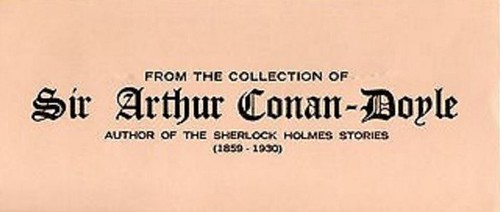

In our recent post about the 1968 sale of Arthur Conan Doyle’s ancient coin collection, the price list referenced that all the coins would be in an attractive folder that would certify the coin was from the collection. We have a picture of one of these folders above.
Each coin and the accompanying paper disc (from ACD’s coin cabinet, with a brief description of the coin in ACD’s handwriting) in a 2 inch by 2 inch plastic coin flip. The folder would be signed by Joseph H. Rose, a numismatist on the staff of Manfra, Tordella & Brookes, who was responsible for the sale of the collection.
Unfortunately, the plastic coin holders in the 1960’s usually contain PVC – polyvinyl chloride – that has a chemical agent that can leech out over time and can cause a green, oily film to form on the coins.
It’s been nearly 40 years since these coins were sold. How many still remain with the small disc in Doyle’s handwriting and / or the folder / certificate?
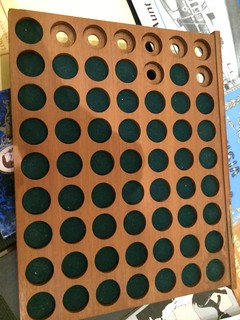
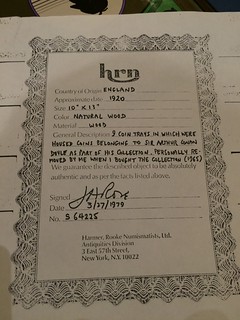
In the Fall 2014 newsletter of the BSI Trust, there was an announcement that a 10”x 11” coin tray which housed coins belonging to Sir Arthur Conan Doyle had been donated to the BSI Trust. In talking to Andy Solberg, chairman of the BSI Trust, he mentioned that he would be taking possession of that coin tray during the January 2015 BSI Weekend and arranged for me to get a picture of the coin tray.
It is believed that the wood tray dates to the 1920’s and measures 10 inches by 11 inches, with holes for 56 coins. Eight of the holes are missing the felt inserts. Below is a copy of the certificate of authenticity signed by Joseph H. Rose in 1979, who sold the collection while working at Manfra, Tordellla & Brookes in 1968.
It’s a shame that the trays were removed from the coin cabinet in the mid 1960’s and dispersed individually over time. They would have more value as a complete set, rather than nine separate trays and an empty cabinet. Oh well!
To read the complete articles, see:
MTB’s 1968 Price List of
Arthur Conan Doyle’s Ancient Coin Collection
(http://fourthgarrideb.com/2016/03/mtbs-1968-price-list-of-arthur-conan-doyles-ancient-coin-collection/)
MTB’s “Attractive Folder” For
Arthur Conan Doyle’s Ancient Coins (http://fourthgarrideb.com/2016/03/mtbs-attractive-folder-for-arthur-conan-doyles-ancient-coins/)
A Tray From Arthur Conan Doyle’s Coin Cabinet
(http://fourthgarrideb.com/2016/03/a-tray-from-arthur-conan-doyles-coin-cabinet/)
To read the earlier E-Sylum article, see:
MORE ON COINS COLLECTED BY SIR ARTHUR CONAN DOYLE
(www.coinbooks.org/esylum_v19n09a29.html)

ARTICLE HIGHLIGHTS METAL DETECTOR HOBBYISTS
The story of how Sal Guttuso found his calling sounds like the beginning of an urban legend for nervous parents: He was playing in an abandoned building across the street from his father’s French Quarter restaurant when a van pulled up. The dilapidated structure usually attracted vagrants, so the van presented a tantalizing deviation from the norm, especially when two men armed with curious equipment and big headphones jumped out. Guttuso followed them.
“They didn’t shoo me off,” he says. In fact, one called him over and pointed to a place in the ground that had drawn his interest. As Guttuso watched, the man dug down into the earth until he found what he was looking for. He extracted a circa-1800s silver dollar from the hole, and then two more.
The man had literally dug up treasure right in front of him.
“Now, looking back on that, I have often wondered if that old boy was just playing a trick on me to get me interested, to get me hooked,” says Guttuso. “Regardless, the end result was the same—I had to have a metal detector.” Now 42, metal detecting has been his “exclusive passion, addiction, hobby, whatever you want to call it”.
It’s his career, as well. Guttuso and his wife Ashley run History Hunts, a metal detector tour company for adventurous treasure hunters.
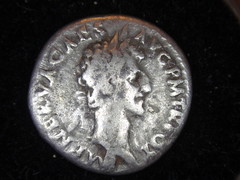 A typical handheld metal detector looks like a stick with a metal donut on the end. The user walks slowly, sweeping (or “swinging”) their
detector across the ground, watching an indicator needle, digital display or listening to headphones (or both) which transmit pings, buzzes and beeps
back to them when they pass over a metal object. To the uninitiated, it can look like someone trying to vacuum the planet while listening to some
tunes.
A typical handheld metal detector looks like a stick with a metal donut on the end. The user walks slowly, sweeping (or “swinging”) their
detector across the ground, watching an indicator needle, digital display or listening to headphones (or both) which transmit pings, buzzes and beeps
back to them when they pass over a metal object. To the uninitiated, it can look like someone trying to vacuum the planet while listening to some
tunes.
In recent years, metal detecting has hit a kind of pop cultural sweet spot: The National Geographic Channel produces a reality show called Diggers and the BBC comedy The Detectorists, which follows the exploits of a fictional metal detecting club, has scored critical acclaim. Enthusiasts can indulge in punny t-shirts (“I dig booty”) or groove to 13 songs about metal detecting by Nashville singer Whit Hill (album name: “I Dug It up”.) Even former Rolling Stones bassist Bill Wyman has caught the bug and sells a signature metal detector. (It literally has his signature emblazoned across the front panel.)
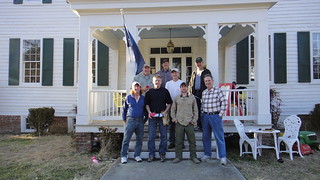 Detectors frequently post videos of their hunts and finds on YouTube. This was how Guttuso got noticed; his videos that earned him a
following among fellow hunters, who asked him to take them out detecting. It wasn’t long before he sensed an opportunity, left his fulltime job at a
big drug company and started History Hunts in 2007. In addition to leading metal detecting tours in near his rural Virginia home, he has taken groups
shipwreck detecting in Florida, gold prospecting in Nevada and relic and coin-hunting all over the southern U.S. He also leads international trips to
Essex County, England.
Detectors frequently post videos of their hunts and finds on YouTube. This was how Guttuso got noticed; his videos that earned him a
following among fellow hunters, who asked him to take them out detecting. It wasn’t long before he sensed an opportunity, left his fulltime job at a
big drug company and started History Hunts in 2007. In addition to leading metal detecting tours in near his rural Virginia home, he has taken groups
shipwreck detecting in Florida, gold prospecting in Nevada and relic and coin-hunting all over the southern U.S. He also leads international trips to
Essex County, England.
Guttuso works with private property owners to organize his hunts and enforces local law. In England, hunters are required to report potentially significant finds, and the British Museum has the first right of refusal. That John the Baptist statue that one of Guttuso’s clients found? It never left home; the museum snapped it up and reimbursed the finder. Guttuso and his patrons also sometimes donate finds to local museums.
You have to love the hunt itself because the score can be elusive. Guttuso related a story of a particularly fruitful hunt near a former hospital site where his group uncovered four Civil War belt buckles in rapid succession. Suddenly, Guttuso also got a signal on his detector that sounded just like those that had heralded the first four finds.
“I’m videotaping, I’m so excited,” he says. “And you know what? At a foot down, it was a flattened out Vienna sausage can. So that’s just the way it goes.”
To read the complete article, see:
The Obsessive Treasure Hunters Who
Travel the World with Metal Detectors (www.atlasobscura.com/articles/the-people-who-travel-the-world-with-metal-detectors)
METAL DECTECTORIST FINDS AN ENTIRE SAXON TOWN
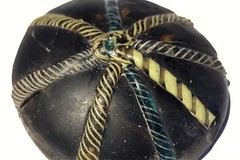
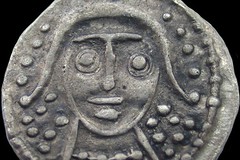
Glass weight and coin among the finds
A rich and sophisticated Anglo-Saxon town emerging from an ancient island in the Lincolnshire marshes has been hailed as one of the most important archaeological finds on British soil in decades.
The previously unknown settlement, which is thought to have been a strategic trading post or an unusually wealthy monastic community, was discovered 1ft below the surface of a field by an experienced metal detectorist.
The first trenches sunk into the clay have revealed ornate writing tools, elegant glass weights and “Cudburg”, a woman’s name, inscribed into a lead plaque, as well as hundreds of coins known as sceattas.
All of these treasures suggest that the town was a cut above the average Saxon farmstead and amounts to a “site of international importance”, a sort of Dark-Age Durham, according to Hugh Willmott, senior lecturer in archaeology at the University of Sheffield.
“It’s a Middle Saxon site that’s been previously completely unknown, and seems to have been pretty high status,” he said. “The difference with this settlement is the nature of it: it’s not just an ordinary rural settlement, it’s encircled with a bank and ditch. The range of finds coming from it tell us this is something really special.”
To read the complete article, see:
Bip, bip, bip, BEEP!
Dectectorist finds an entire town (www.thetimes.co.uk/tto/science/article4703212.ece?shareToken=35960831475c3dc968a14f37486ae2a0)

ROMANIAN POLICE SEIZE STOLEN COINS
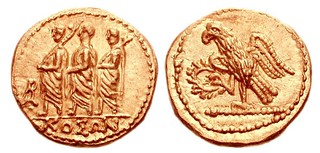 Romanian police have seized gold coins and a treasure trove of statues which are over 2,000 years old allegedly stolen from archaeological
sites and destined for auction, prosecutors said Monday.
Romanian police have seized gold coins and a treasure trove of statues which are over 2,000 years old allegedly stolen from archaeological
sites and destined for auction, prosecutors said Monday.
Three golden coins minted under the Dacian King Koson, 1,050 ancient silver coins, as well as 102 metal objects and 12 vases and ceramic statuettes were seized last week in raids on an auction house and three people claiming to be collectors, they said.
"At least some of these objects come from treasures stolen from protected archaeological sites," prosecutor Augustin Lazar, in charge of the investigation in Alba Iulia, central Romania, told AFP.
He said some of the pieces are so rare that it difficult to put a value on them.
Numerous precious coins, mostly coming from illegal archaeological digs, have been found recently thanks to "systematic surveillance of the websites of Romanian and foreign auction houses," a police source told AFP.
Items seized last week will be examined by experts at Romania's national Historical Museum, who will decide on a case-by-case basis if they should be confiscated or returned to their owners, said Lazar.
The Artmark auction house, targeted in the raids, said it had told police and the ministry of culture in advance of its plans organize sales of objects which could be part of the country's national heritage, but had not received a reply.
"By offering the police our full support for a proper investigation, we hope to be able rapidly to resume our legal activities," Artmark said in a statement.
To read the complete article, see:
Romanian police seize stolen archaeological treasures taken from sites and destined for auction
(http://artdaily.com/news/85468/Romanian-police-seize-stolen-archaeological-treasures-taken-from-sites-and-destined-for-auction#.VtzRp_k4FhE)
MALAYSIAN COIN COLLECTORS LINED UP FOR NEW ISSUE
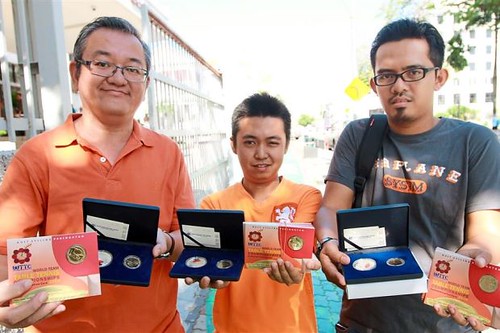
BUSINESSMAN Stamp Ong waited nearly 10 hours to get his Coloured Silver Commemorative Coin issued by Bank Negara Malaysia (BNM) in conjunction with the World Team Table Tennis Championships 2016.
Ong, 40, waited opposite the bank’s Penang branch in Lebuh Light from 11pm on Sunday, so that he could be first in line when the bank’s doors opened at 8.45am.
An avid coin collector, Ong’s effort paid off when he managed to buy 11 pieces of the Coloured Silver edition, available on a first-come-first-served basis.
Only 500 pieces of the Coloured Silver coins are available in the whole country.
“I heard there are only 30 pieces available at this branch. It is priced at RM212 inclusive of GST, but can fetch up to RM500 in resale value,” said Ong, who also bought 10 Nordic Gold Brilliant Uncirculated (B.U) Commemo-rative Coins when met outside the bank in Penang on Monday.
BNM has issued three specifications of the commemorative coins, namely Coloured Silver Commemorative Coin, Copper Commemorative Coin and Nordic Gold Brilliant Uncirculated (B.U) Commemo-rative Coin.

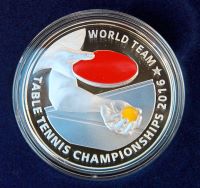 The Coloured Silver is proof-coloured coin made of fine silver with 99.9 purity and weighs 31gm each.
The Coloured Silver is proof-coloured coin made of fine silver with 99.9 purity and weighs 31gm each.
The Copper Commemorative is made of pure copper with 99.9 purity and weighs 130gm each, while the Nordic Gold is sold at RM10 each.
“The commemorative sets are also sold in a set of two, which consists of the Coloured Silver and Nordic Gold coins.
“There are 2,000 sets of the pair of two coins, sold at RM250 each,” said BNM in their official website.
Suhaime Sahak, 48, from the Customs Department managed to grab two sets of the Coloured Silver and Nordic Gold combination sets, but missed out on the Coloured Silver coins.
“I rushed here immediately after the ferry reached the island at 7am.
“Unfortunately, the Coloured Silver coins were sold out by 9.30am,” he said.
To read the complete article, see:
Special coins snapped up
(www.thestar.com.my/metro/community/2016/03/03/special-coins-snapped-up-avid-collectors-make-beeline-for-keepsakes-issued-to-mark-world-table-tenni/)
THE BOOK BAZARRE
AUSTRALIA WWII REFUGEE CAMP SCRIP NOTES OFFERED
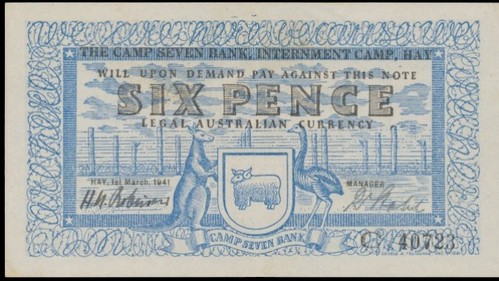
Refugees, and what to do with them, were also a major concern during the Second World War. One solution was to place them on a ship and send them to the other side of the world, Australia for example. Which explains why a shipload of German and Austrian refugees arrived in Sydney on board the Dunera. The British suspected them of being spies or Nazi sympathisers, which was unlikely as most were Jewish.
From Sydney, the Dunera Boys, as they were later called, were taken by train to Camp Seven, near Hay. Some were wealthy businessmen. Their money was confiscated and while interned, the only available currency was a series of banknotes and some generic tokens.
The Hay banknotes were special. They were designed by the internees then printed by a local newspaper. They were so sophisticated that the Australian Treasury feared that they would be traded outside the camp. After three months of circulation in 1941, the notes were confiscated and destroyed, although some examples were kept as souvenirs by internees.
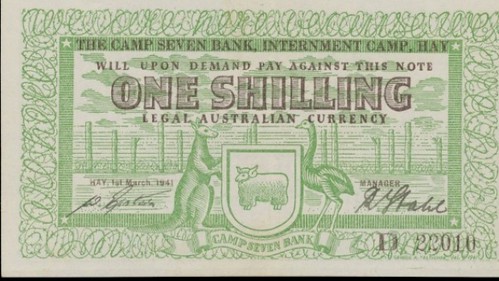
This then is a classic case of the rarity factor.
A catalogue prepared by M. H. R. Bullus (now out of print), records that only 2000 of the two shilling notes were printed, with about 3000 for other denominations. A survey published in 1994 recorded only 174 surviving notes.
According to the laws of supply and demand, the value of the surviving notes has increased dramatically over the past decade.
So the news that a complete set of the banknotes, covering all denominations and combinations of signatures, is to be offered as part of Australian auction house Mossgreen's first coins and banknotes sale has sparked great interest. To their knowledge this is the first complete set of set to be offered at a public auction. The sale will be held on Thursday evening in Melbourne.
The estimates for the banknotes are conservative, according to specialist Nick Anning, given that most of the collection are in the highest EF (extremely fine) or UNC (uncirculated) categories. Top value of $15,000 is for a two shilling, red and black note in uncirculated condition. A green one shilling note, also uncirculated, is given estimates of A$12,500 ($13,640). Blue sixpence banknotes are valued at $8000, or $10,000 for a consecutively numbered pair.
To read the complete article, see:
During WWII, refugees in
Australia had their own currency (www.stuff.co.nz/business/money/77486424/during-wwii-refugees-in-australia-had-their-own-currency)
SWISS 5-FRANC COIN TARGETED BY COUNTERFEITERS
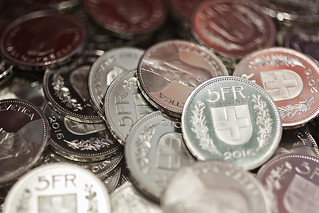 Banknotes aren’t Switzerland’s only form of cash to pique the interest of criminals.
Banknotes aren’t Switzerland’s only form of cash to pique the interest of criminals.
While Swiss National Bank officials field accusations that their 1,000-franc bills facilitate illegal activity, their coinage colleagues at Swissmint have a headache of a different sort. Forgeries of the highest-denomination 5-franc ($5) coin have surged in the past two years, with criminals seeking to profit from one of the world’s most valuable pieces of metal money circulated for daily use.
In 2014, 14,000 forged 5-franc pieces were removed from circulation. Last year the toll was 7,600, official statistics show. That compares with less than 1,000 annually in previous years.
“Of course the crooks look where they can make the most money,” said Swissmint Managing Director Marius Haldimann, speaking from his office in a belle epoque building in Bern. “Most fakes come from Italy. Given the material costs, you really need organized crime to produce them.”
In one instance, a group of Italians was stopped at the border, their small Smart car weighed down with 5,000 fake 5-franc pieces.
While some fakes are of high quality, others are easily detected. “Even the man on the street can tell something is amiss,” Haldimann said, dropping a forged piece onto a table. It made an odd, tinny clunk.
Despite the appeal of faking Swiss coins, the incidence of forgeries is relatively low.
Just 1 in a thousand 5-franc coins turn out not to be legitimate, Swissmint says. That compares to 2.6 percent of 1-pound pieces, according to Britain's Royal Mint. The low Swiss ratio is due in part to the alloy used, the high-quality workmanship, and the design, which includes security features.
To read the complete article, see:
Swiss Franc
Coin That Buys a Bratwurst Becomes Target of Crooks
(www.bloomberg.com/news/articles/2016-03-04/swiss-franc-coin-that-buys-a-bratwurst-becomes-target-of-crooks)

COUNTERFEIT SHOVER TARGETS CALIFORNIA GIRL SCOUTS
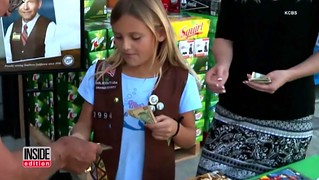 Police are searching for a cookie monster who stole from a Girl Scout. Launa Archer and her mom were selling the popular cookies outside a
grocery store in California when someone wanted to buy 5 boxes for $25. The 9-year-old brownie trooper was handed a $100 bill to pay for them and she
then gave the customer $75 in change. Turns out, the bill appeared to be a fake.
Police are searching for a cookie monster who stole from a Girl Scout. Launa Archer and her mom were selling the popular cookies outside a
grocery store in California when someone wanted to buy 5 boxes for $25. The 9-year-old brownie trooper was handed a $100 bill to pay for them and she
then gave the customer $75 in change. Turns out, the bill appeared to be a fake.
To read the complete article, see:
9-Year-Old
Girl Scout Gets Counterfeit Money While Selling Cookies Outside
(www.msn.com/en-us/video/watch/9-year-old-girl-scout-gets-counterfeit-money-while-selling-cookies-outside/vi-BBqcUB9)
HOBO CARVERS CREATE UNIQUE COIN PUZZLE ART
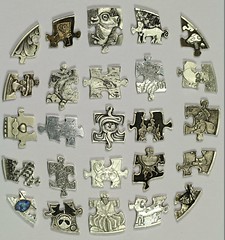
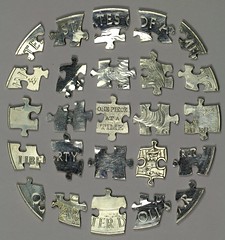
This amazing piece of numismatic art was the idea of Don Berry.
First, Don had a 2011 Gettysburg America the Beautiful 5 oz. Silver Bullion Quarter hand cut into a 25-piece puzzle by Jeremy Barrett of Coin Cut Art.
Don then sent the individual puzzle pieces to fellow artists and carvers of hobo nickels. The artists who participated in this project were located all over the World and most carved their pieces of the puzzle without knowing what the other pieces would ultimately look like. Of course, as you can see in the finished project, some of the artists who obtained adjoining pieces obviously collaborated in their designs.
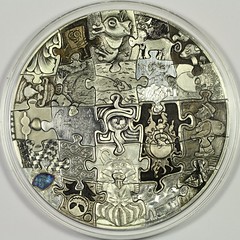

Over the period of several months, the individual pieces of this puzzle coin were carved by the following artists: Pedro Villarrubia, Blanca De La Hoz, Joe Paonessa, James Boudreau, Sean Bennington, John Schipp, Mike Lyness, Ben Proctor, Will Clark, Matthew Hagermann, Simone Cervellati, Jay DeBoer, Robbie Morris, Shane Hunter, Barb Hunter, Adam Leech, Lou Acker, Don Berry, David Raymond, Paolo Curcio, Jared Eason, Chris DeFlorentis, Harry Caldwell IV.
The artists were united in their efforts on this project with the goal of supporting their friend and fellow artist, Andy Gonzales.
This impressive creation of the community of hobo nickel artists has stunning detail and is so much more amazing in hand than any photos can show. The puzzle coin will be on display at my table at the Buena Park coin show March 12-13 for those of you in Southern California who wish to experience this masterpiece in person.
A unique opportunity to obtain this awesome piece of art produced by over 20 well-known carvers of hobo nickels.
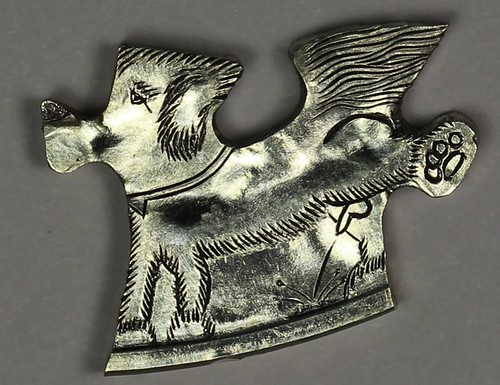
To read the complete eBay listing, see:
(www.ebay.com/itm/Hobo-Nickel-Style-Hand-Carved-25-Piece-Puzzle-Coin-From-ATB-5-oz-Silver-Quarter-/331793562829)


